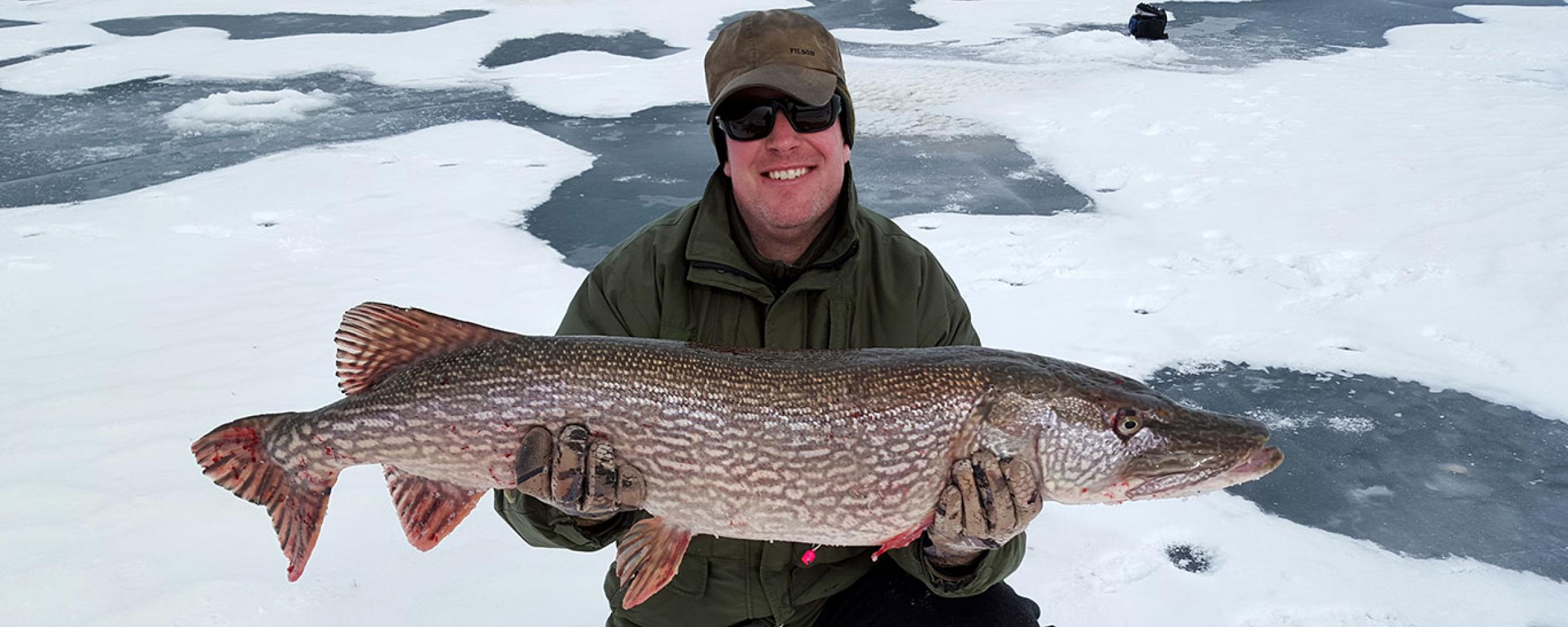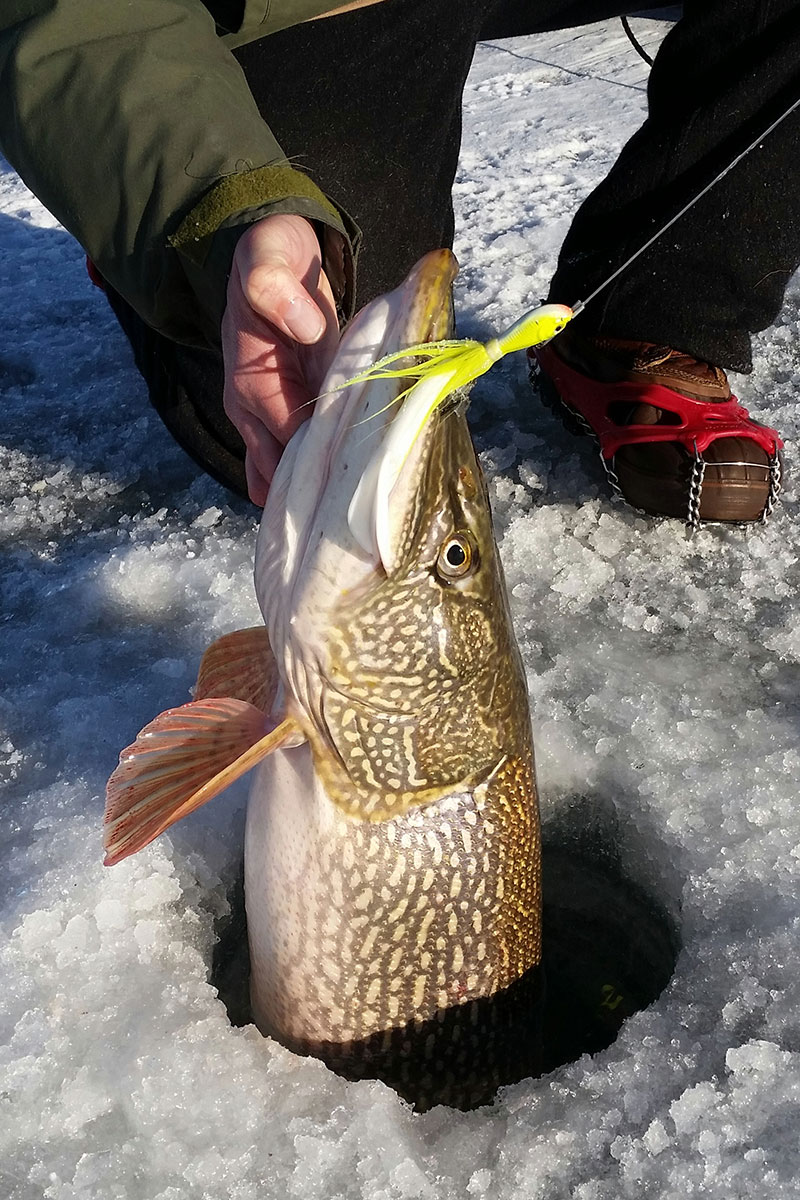
Targeting Big Pike in Winter
Fisheries Biologist Shares Ice Fishing Insights
If there is such a thing as an embarrassment of riches, North Dakota’s anglers have experienced it in recent years.
Our "big three" walleye fisheries – Lake Sakakawea, Devils Lake and the Missouri River/Lake Oahe – continue to validate their nationally renowned reputations as destination fisheries. Other new lakes created from the abundant snowfall during the winters of 2008-09 to 2010-11 have now developed into outstanding fisheries.
We are in the middle of the best yellow perch boom since the early 2000s; the walleye fishing on our prairie lakes has never been better; and a generous mix of traditional and new northern pike fisheries are found in every corner of the state. At the same time, quality largemouth bass, smallmouth bass, and trout fisheries are not hard to find; opportunities for bluegill and crappie have likely never been better; and Lake Sakakawea arguably just produced its best salmon fishing season in decades.
Wow.
Like a lot anglers, I consider myself an opportunist and I am happy to pursue the best fishing available when and where it occurs, no matter the species.
Late ice walleye bite on a prairie lake? I’m there. Crappie are biting on Lake Oahe? I’m rigging up slip bobbers. Springtime walleye on the Missouri River? Count me in. Largemouth bass biting on a small southwest reservoir? I’ll get my spinnerbaits. Early morning trout bite in the Garrison Dam Tailrace? Who needs sleep.
I’ve done my best to take advantage of the diversity of exceptional and abundant angling opportunities in recent years, but if anything has risen to the top and become a favorite – obsession, maybe? – it’s ice fishing for whopper northern pike.
North Dakota has a long history of producing some truly world-class northern pike. Many anglers have encountered fish surpassing 20 pounds and more than a handful of 30-plus-pound pike have been verified over the years.
Hooking into these apex predators has produced some of my most memorable fishing experiences and, through much trial and error, I have found some strategies that have helped me put more big pike on the ice ... and back in the water.

Big northern pike, like this 19-plus pound fish, like big baits.
Fish Where Big Pike Live
Simple enough … you can’t catch what isn’t there. Many excellent northern pike fisheries are scattered across North Dakota, but few consistently offer the potential for trophy fish. To grow large, northern pike typically need to live for 10 or more years in a water body with enough depth to offer a cool water refuge in the heat of summer, as well as suitable sizes of forage.
Pike in our productive, shallow prairie lakes tend to have a live-fast-and-die-young lifestyle, which isn’t conducive to growing to trophy sizes. These lakes typically lack cool water habitat in summer and have simple forage communities. Warm water and a diet of fathead minnows can lead to some exceptional northern pike growth rates in their early years, but these conditions seldom push pike past 5 years or 10 pounds.
The discussion on where to target large pike in North Dakota really begins with the Missouri River System.
The Missouri River System (Sakakawea, Missouri River/Oahe) alone has accounted for approximately 80 percent of the 20-pound and larger northern pike submitted to the North Dakota Game and Fish Department’s Whopper Club. This system offers both the cool water summer habitat and forage communities necessary to produce exceptional pike.
What’s crucial is the ability of these fish to find suitable-sized forage as they increase in size. Fathead minnows and small perch are great forage for 20-inch pike, but the availability of larger forage such as shorthead redhorse, white sucker, cisco, goldeye and many others found in the Missouri River System, ensures the availability of large forage as the pike grow.
While the Missouri River System is rightly the top destination for anglers seeking trophy northern pike, several other fisheries provide the necessary environmental and forage conditions to produce large pike, and have a history of doing so. Most notably, Devils Lake, Lake Audubon, Pipestem Reservoir, Jamestown Reservoir, Lake Ashtabula and Heart Butte Reservoir (Lake Tschida).
When to Fish in Winter
Of less importance than where to fish is when. If you are on the right body of water, any day that offers safe ice and tolerable weather may produce the fish of a lifetime. On the Missouri River System, reasonably safe ice may not exist until late December or early January, but it may also persist into April some years.
I generally target deeper depths, sometimes 20 feet or more, near the mouths of large bays early in the ice fishing season, and make my way into the bays and shallower water as the winter progresses. Water clarity often plays a role in site selection, since pike are sight-feeders.
Baits and Lures
Northern pike are not known as exceptionally picky eaters and plenty are caught on freezer-burned smelt, gobs of fathead minnows on a treble hook, or even hotdogs. However, when fishing dead baits, I prefer to use the largest vacuum-sealed rainbow smelt that I can find. I believe smelt in good condition lead to more bites than freezer-burned baits with missing fins and scales.
Bait and lure size does matter when targeting large pike. Numerous diet studies have found that northern pike select prey that is one-fourth to
one-third their body length in size, so 10-inch rainbow smelt or large artificial lures are not out of the question when targeting pike of 40 inches or more.
I typically position my dead baits about 18 inches off the bottom. However, if water clarity is good, I will often position baits 3 feet or more off the bottom as pike are accustomed to attacking prey above them.
Traditional tip-ups are certainly tried and true, but I use commercially available variations of the tip-up concept that allow using a rod and reel instead.
Using a rod and reel, especially the drag feature of the reel, to fight large pike has helped me land many fish that I am convinced I would have lost hand-lining them in under a traditional tip-up.
North Dakota fishing regulations allow the use of a maximum of four fishing lines per angler when ice fishing. I deploy three rods with dead baits and actively jig with a fourth. Aggressively jigging large, vibrating lures and bucktail jigs with plastic trailers are some of my go-to presentations.
There are several commercially available ice fishing rods that were designed for targeting lake trout that are well suited to trophy pike. I prefer bait casting styles, as they allow my catfishing reels to do double duty on the ice. The 40-pound-test braided superline on these reels is more than adequate, and I have taken the lead from our friends in the musky fishing community and build my own leaders from 100-pound test fluorocarbon leader material.
Catch-and-Release Tips
Northern pike make excellent table fare and I harvest a few every winter. However, I prefer 24- to 30-inch pike for the table and release larger fish. (Visit the Game and Fish Department’s website, gf.nd.gov, for tips on removing the Y-bones from pike.)
When practicing catch-and-release, keep the following in mind: 1) land fish as quickly as possible; 2) while the fish will be lifted vertically out of the ice hole, keep the time the fish is held vertically to a minimum to prevent damage to internal organs; 3) avoid contact with gills or eyes; 4) have pliers, jaw spreaders and camera ready so hooks can be removed and photographs taken without delay, and; 5) return fish to the water as quickly as possible.
A good rule of thumb is the fish should not be out of the water any longer than you can hold your breath. This is especially true in winter as a fish’s eyes and gills are quickly damaged in freezing temperatures.
Whether targeting trophy fish or not, pike fishing opportunities have never been more abundant in North Dakota than they are now. Anglers pursuing our official state fish are sure to bank many more memories in the months ahead.
